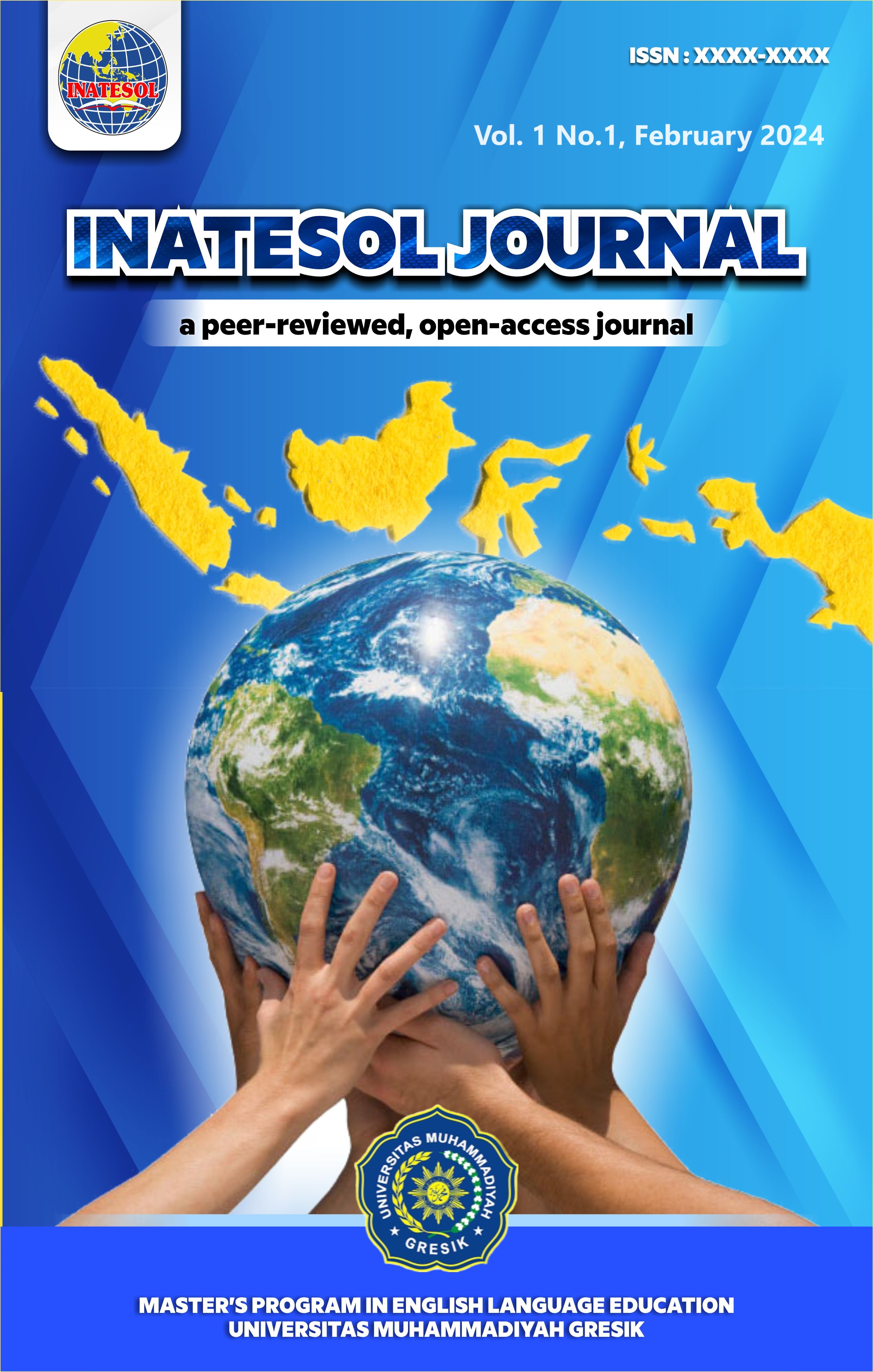An Analysis of Illocutionary Act on Song Lyrics by Sia Furler in The Album This is Acting
DOI:
https://doi.org/10.30587/inatesol.v1i1.7363Keywords:
illocutionary acts, declarative acts, speech actsAbstract
This study examines the illocutionary acts present in the lyrics of the album "This Is Acting" by Sia Furler. Utilizing a qualitative research approach, the study categorizes and analyzes the various types of illocutionary acts found within the album's songs. The data collection process involves selecting song lyrics from the album and identifying instances of illocutionary acts, which are then classified into representative, directive, commissive, expressive, and declarative categories. The findings reveal that the representative type of illocutionary act is the most prevalent, with instances of describing situations, stating facts, and conveying truths forming a significant portion of the analyzed data. Following this, directive illocutionary acts, including commands and invitations, are also prominent within the lyrical content. Commissive acts, expressing hopes, rejections, threats, and offers, represent a smaller yet significant portion of the data. Additionally, the analysis identifies expressive acts, such as expressions of praise, thanks, and regret, as well as declarative acts, featuring expressions of confession. This research contributes to the understanding of linguistic expressions in song lyrics and sheds light on how illocutionary acts are employed to convey messages, emotions, and themes within the context of music. Furthermore, it suggests avenues for future research, including exploring alternative media forms and applying the analysis of speech acts to literary works. Overall, this study offers valuable insights into the intricate interplay between language and music in conveying meaning and emotion to listeners.
References
Griffiths, P. (1959). An Introduction to English Semantics and Pragmatics. In H. Giegerich (Ed.), Nucl. Phys. (Vol. 13, Issue 1). Edinburgh University Press.
Jarassri, K., & Phennapha, K. (2020). Illocutionary Act Analysis of Encouragement Songs. Journal of MCU Humanities Review, 6(1), 127–136.
Karisma, P. F., & Mariana, A. (2018). The use of Illocutionary Act In “WONDER” Movie by RJ. PALACIO. British Umgo, 66(2), 37–39.
Lestari, D. U., Setyaji, A., & Affini, L. N. (2022). The analysis of assertive speech acts on the speech of Barack Obama at the english speech channel about ignorance is not a virtue. Proceeding of English Teaching, Literature and Linguistic (ETERNAL) Conference, 2, 136–145.
Maruf, N., & Tanduk, R. (2021). A Cognitive Linguistics Study to Reveal the Concept of Death of Indonesian Indigenous Tribe. Budapest International Research and Critics Institute (BIRCI-Journal): Humanities and Social Sciences, 4(2). https://doi.org/10.33258/birci.v4i2.1969
Miles, M. B., & Huberman, A. M. (1994). Qualitative Data Analysis. In R. Holand (Ed.), CEUR Workshop Proceedings (2nd ed., Vol. 1304). SAGE Publications, Inc.
Nareswara, R., & Suseno, B. (2019). A Pragmatic Analysis of Expressive Speech Acts in The Movie Venom. Ahmad Dahlan Journal of English Studies, 15.
Nurfaizi, M. A., & Aji, A. S. (2022). An Analysis on Illocutionary Act in Song “ 1x1 ” By Bring Me the Horizon. 282–292.
Parmadi, A. (2020). Illocutionary and perlocutionary acts in bulletproof boys leader kim namjoon’s speech entitled ‘speak yourself’ at the 73rd session of un general assembly. Universitas Negeri Semarang.
Piscesco, P. omar. (2022). An analysis of expressive illocutionary acts found in “ Midsommar ” movie : Pragmatics approach. Universitas Putera Batam.
Searle, J. R. (1979). Studies in the theory of speech acts. In Cambridge University Press. United States of America by Cambridge University Press, New York.
Silalahi, P. V. (2016). A Highlight on Pragmatics. Language, 16(01), 84.
Tanduk, R., Maruf, N., & Suluh, S. (2021). Myths and Ideology in Customary Ritual of Ma’tammu Tedong for Life of Toraja People. Budapest International Research and Critics Institute (BIRCI-Journal): Humanities and Social Sciences, 4(2). https://doi.org/10.33258/birci.v4i2.1979
Ulyah, F., Anwar, K., & Maruf, N. (2021). The Application of English Songs in Teaching Conditional Sentences through Google Classroom. Budapest International Research and …, August.
Zuhri, S., Anwar, K., & Maruf, N. (2021). The correlation between extensive reading , critical reading , and self- esteem in students ’ reading abilities. Budapest International Research and Critics Institute-Journal (BIRCI-Journal), 4(3).
Downloads
Published
How to Cite
Issue
Section
License
Authors who publish with this journal agree to the following terms:
- Authors retain copyright and grant the journal right of first publication with the work simultaneously licensed under a Creative Commons Attribution License that allows others to share the work with an acknowledgement of the work's authorship and initial publication in this journal.
- Authors are able to enter into separate, additional contractual arrangements for the non-exclusive distribution of the journal's published version of the work (e.g., post it to an institutional repository or publish it in a book), with an acknowledgement of its initial publication in this journal.
Authors are permitted and encouraged to post their work online (e.g., in institutional repositories or on their website) prior to and during the submission process, as it can lead to productive exchanges, as well as earlier and greater citation of published work (See The Effect of Open Access).



_3.png)
_2.png)



